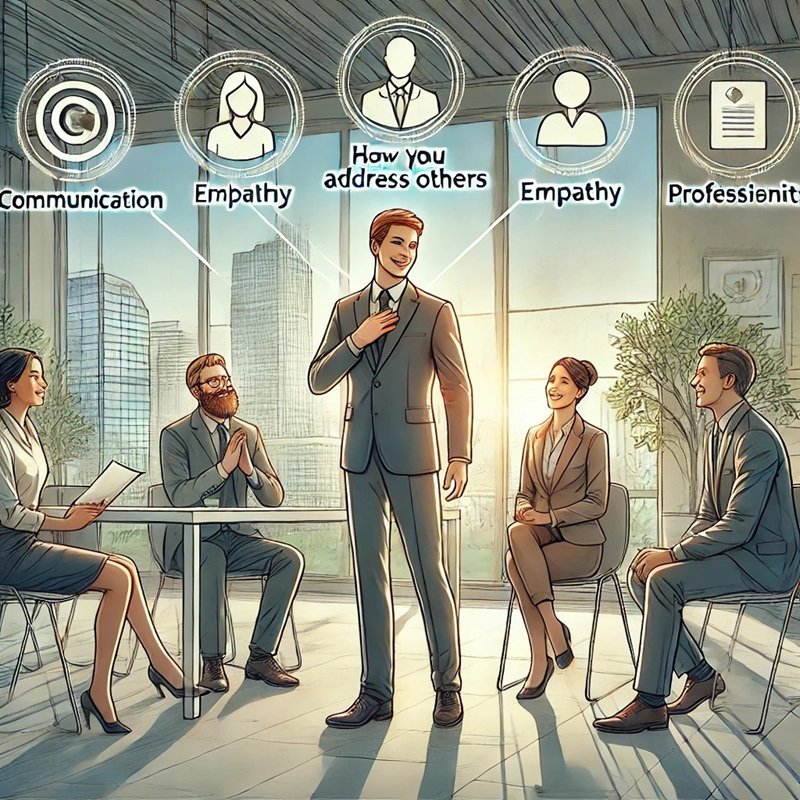Address | Second Aspect of Personality Development for Professionals
In the previous article, we explored the significance of Dressing—the first aspect of personality development—and how it plays a powerful role in shaping first impressions and professional identity, particularly in architecture and related fields. Now, we move on to the second aspect of personality development: Address.
While the word “address” may commonly refer to location or speech, in the context of personality development, it refers to the way you approach, greet, and interact with others. It is about your tone, manner, and conduct when engaging with individuals across various social and professional hierarchies. How you address others is one of the most revealing aspects of your personality. It communicates your confidence, upbringing, social awareness, and respect for other people.
Before diving deep, let’s remind ourselves of the Seven Key Aspects of Personality Development for Professionals:
- Dress
- Address
- Good Language
- Punctuality
- Planning your work
- Habit to postpone the work
- Telephone conversation
What Do We Mean by ‘Address’ in Personality Development?
Address, in this context, is the manner in which you interact and express yourself when speaking to others. It includes:
-
The way you greet people
-
The words and tone you use when starting or joining a conversation
-
How you show respect for age, seniority, and context
-
Your etiquette in formal and informal situations
-
The ability to introduce yourself and others with clarity
-
The politeness and sensitivity with which you speak, especially in group or professional settings
In a professional environment—especially in fields like architecture, planning, and engineering—how you address others can influence your relationships, your reputation, and your growth. Whether you’re dealing with a senior partner, a new intern, a client, or a contractor, addressing others appropriately shows that you are mature, composed, and considerate.

Why Does It Matter?
You may have brilliant ideas and strong design skills, but if you cannot express them respectfully, or if you come across as dismissive or impolite, your message can be lost—or worse, you may damage professional relationships. Your manner of address can either open doors or shut them.
In multidisciplinary teams, your projects depend on collaboration. Addressing your colleagues and collaborators with care builds trust and rapport. On the other hand, poor manners—interrupting others, talking over people, ignoring introductions, or using the wrong tone—can create discomfort and even conflict.
In essence, your ability to address others properly is one of the strongest indicators of your emotional intelligence and professional readiness.
The Power of a Simple Greeting
When you meet someone—whether a stranger or someone you already know—greeting them appropriately is a basic form of respect. Yet, many people fail to do so, often because of shyness, overconfidence, or a lack of habit.
Saying “Good morning,” “Hello,” “Hi,” or “Namaste” is not just a formality. It signals that you acknowledge the person’s presence and that you respect their time and role. These small interactions lay the foundation for smoother communication.

Cultural Awareness in Greetings
If you’re working in a multicultural environment—or on international projects—it’s important to understand the appropriate greeting norms in different cultures. A handshake may be expected in some cultures, while in others, a bow, nod, or verbal greeting may be more respectful. Being aware of these differences shows cultural intelligence and adaptability—qualities that are highly valued in today’s global practice.
Addressing Seniors vs. Peers vs. Juniors
One of the most important skills you can develop is the ability to adapt your address depending on the relationship.
1. Addressing Seniors or Superiors
When speaking to someone older or more experienced than you—be it a professor, team leader, client, or consultant—your tone should always reflect courtesy and consideration. Use respectful titles such as Sir, Madam, or Dr. unless invited to use first names. Phrases like:
-
“How do you do?”
-
“It’s a pleasure to meet you.”
-
“May I ask your thoughts on this?”
…show humility and a willingness to learn.
2. Addressing Colleagues and Peers
With peers, a more relaxed yet still professional tone is appropriate. Use names, smile, and speak with openness. If working in international settings, using polite phrases like “Would you mind if…?” or “Shall we…?” shows collaboration, not command.
3. Addressing Juniors or Support Staff
Your address to junior team members or support staff reflects your character. Respect goes both ways. Being kind, clear, and inclusive when speaking to interns, trainees, or admin staff builds a positive and inclusive environment. Avoid using a condescending tone or speaking in directives alone.
Mastering the Art of Self-Introduction
In many settings, whether at meetings, networking events, or site visits, you may need to introduce yourself. Rather than waiting for others to remember your name—or worse, assuming they already do—it’s good etiquette to introduce yourself clearly before entering a conversation.
For example:
-
“Good morning, I’m Ayesha from the design team. We met briefly at the site visit last week.”
-
“Hello, I’m Rehan. I’m working with the planning team on the environmental impact side.”
A good self-introduction includes your name, your role, and, if needed, a quick reference point. It puts others at ease and sets the stage for smoother communication.
Listening Before Speaking
Address is not just about what you say—it’s also about how well you listen.
Interrupting someone mid-sentence, dominating a group conversation, or speaking without understanding the context can make you appear inconsiderate or impatient. Especially in design meetings, where multiple viewpoints matter, listening actively before you respond allows you to offer more thoughtful, targeted comments.
Here’s how you can improve your listening address:
-
Nod or show you are attentive without interrupting.
-
Wait for a pause to respond.
-
Take notes if needed, so you don’t forget your points.
-
Paraphrase the other person’s views before replying to show that you understood.
This simple habit transforms your presence into that of a respected contributor, not just a speaker.
Public Speaking and Group Address
In architecture and planning, professionals often have to speak in groups—whether in design reviews, public consultations, or committee meetings. How you address the group is just as important as what you say.
Key tips include:
-
Begin with a clear greeting and purpose:
“Good afternoon. I’m here to present our approach to the proposed housing development.” -
Use inclusive language:
Instead of saying “I did this”, try “Our team explored the following options…” -
Modulate your tone and pace:
Speak clearly, pause to emphasise points, and maintain a warm, confident tone. -
Maintain eye contact:
Whether addressing one person or a group, eye contact shows sincerity and helps build rapport.
The Role of Email and Written Address
In today’s digital workspace, your address is not limited to face-to-face interactions. Your written tone in emails, messages, and documents reflects your personality just as much.
Some key principles for good written address:
-
Use salutations: Begin with “Dear [Name],” or “Hi [First Name],” depending on formality.
-
Be polite and professional: Always say please, thank you, and kind regards.
-
Avoid abrupt or unclear messages: Never send one-word emails like “Done” or “Noted”—expand it politely.
-
Proofread: Errors in spelling or tone can alter your message and affect how you’re perceived.
Common Mistakes to Avoid in Address
Let’s look at some common pitfalls professionals must avoid when addressing others:
-
Ignoring seniors or walking past them without acknowledgement
-
Using slang or overly casual language in formal settings
-
Assuming first-name basis without invitation
-
Interrupting or speaking over others
-
Using passive-aggressive tones in emails
-
Failing to introduce yourself in new or large meetings
-
Being too formal in casual, creative team environments (balance is key)
Address and Leadership
The way you address others has a direct impact on your leadership presence. Leaders are often those who make others feel heard, respected, and valued. Whether you’re leading a project, mentoring an intern, or representing your firm, your speech and mannerisms will influence how others respond to you.
Empathetic and thoughtful address can:
-
Defuse tension in difficult conversations
-
Inspire confidence in your team
-
Foster collaboration across disciplines
-
Establish a tone of mutual respect and transparency
Final Thoughts
In a professional landscape as collaborative and interdisciplinary as architecture, the way you address others—whether in person, in writing, or in groups—is one of your most powerful tools. It reflects your values, your mindset, and your readiness to work respectfully with people of all backgrounds and positions.
A well-developed personality is not just seen in how you dress or how timely you are—but in how you speak, listen, and interact with those around you. Mastering the art of address allows you to build relationships, influence conversations, and create environments where people feel respected and heard.
In our next article, we’ll explore the third aspect of personality development: Good Language—and how your choice of words, tone, and communication habits can significantly shape your professional journey.

Well done here! I really like your post because it is very informative and interesting! 🙂 Knowing these 7 factors can advanced your own personality development.